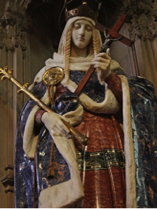Heraldic symbolism of Raitt Coats of Arms
In his 1900 Rhind lecture on Heraldry in Relation to Scottish History and Art, James Balfour Paul opines "Often, no doubt, the coats were what are called canting or armes parlantes, and contained some fanciful allusion to the name or character of their owner; but just as often the shield was simply painted in two colours, divided by the natural strengthening bars which stretched across its surface, or even occasionally in a simple undivided colour.
It is, indeed, the opinion of the best authorities that these bars were the origin of what are called heraldic ordinaries; and these simply painted shields form the very earliest examples of anything like Heraldry….. It must not be supposed, however, that at so early a date as the 11th century there was anything like a system of Heraldry. But when a knight had used the same cognisance all through his life, and had borne it bravely in the thick of battle, it was only natural that his descendants, proud of the distinction which had been won, should adopt the same device as had been borne by their ancestor.
But while isolated instances of what appears very like Heraldry occur early in the 12th century, if not, indeed, in the 11th, it may be stated broadly that it was not till the period of the third crusade (1189) that arms as hereditary distinctions of a family came into notice. By the 13th century they had become firmly established as a feature of the chivalry of Europe, and the term "coat of arms" dates from this period, the custom being to have the arms emblazoned on a surcoat or tunic, which was worn over the armour itself. The first Scottish king who bore arms was Alexander II (1214-1243)."
It is also worth pointing out here that unlike in England, in Scotland the motto forms a definite part of the armorial bearings. It can only be borne by authority, and changed by re-matriculating the arms; and it must be placed in the position specified in the blazon, i.e. in the compartment beow the shield, or above the crest.
Cross
A cross often signifies the christian faith of the bearer, and service in the crusades. The Crusades, between 1095 and 1271, were essentially undertaken to restore Christian control of the Holy Land. The Crusaders used the Christian cross as their symbol in the belief that it made them invincible against the Muslim armies. Although the red cross of the Knights Templar is one of the most familiar associated with the Crusades, the principle nations of Christendom were said to be distinguished by different coloured crosses from the third Crusade (1187) onwards. A plain cross that divides the shield into roughly equal portions is known as a Greek cross. The saltire cross of St. Andrews signifies endurance of hardships and suffering for faith.
The engrailed cross is comparatively rare - the roll of Edward II (1307) only having two examples. Much has been read into its significance (see blog entry) but these interpretations seem fanciful. According to Gerard Brault's Early Blazon: Heraldic Terminology in the Twelfth and Thirteenth Centuries, the word comes from Old French engreslé and is considered to be synonymous with another heraldic term - indented. It is reasoned that engreslé is a derivative of Old French graisle or gresle meaning slender or sharp (Latin, gracilis, slender).
Although certain shields in 13th century sources already show the characteristic concave indentations indicated by the modern term engrailed (Middle French engrêlé) the latter term became fixed in this meaning only subsequently when many other such distinctions were also made.
Anchor
An anchor stands for hope or religious steadfastness
Dolphin
A dolphin implies swiftness, diligence, salvation, charity, and love
Hunting horn
A hunting horn signifies one who is fond of the chase and high pursuits
Lines
Engrailed and invected both mean earth or land
Dancette means water
Colours
Or (gold) signifies generosity and elevation of the mind
Sable (black) stands for constancy or grief
Argent (silver or white) means peace and sincerity
Gules (red) implies warrior or martyr, military strength and magnanimity
Yellow, is the first in estimation, and represents the glorious sun: among precious stones, the shining topaz; and among metals (the most valuable of all others), gold. It is called in blazon, or, from the Latin word aurum, which signifies gold; or rather from the French word or, of the same interpretation. This colour, by reason of its similitude to so excellent and valuable things in the elementary world, doth signify wisdom, riches, magnanimity, joyfulness, and elation of mind.
It is interesting to note that King William I of Scotland chose to have a yellow ground for the red lion in 1180. Whether this influence the choice of yellow for the Raitt arms is not known.
Black is the most ancient of all colours (for darkness was before light, and without light all is black.) It is the colour of mourning, and possesses the fifth place. Saturn is the planet to which it is compared ; and also represents the valuable diamond. It is termed Sable, from the Latin word sabulum, that is, gress-sand or gravel. It signifies to the bearer, constancy, divine doctrine, and loss of friends.
The black cross
It is interesting to speculate on the origin of the Raitt Coat of Arms. Whether Sir Gervaise de Rait and his forebears or descendants actually went on a Crusade to the Holy Land to fight the Saracens is not certain. It is thought that in the days of Alexander III (1241-1286), Rait went to the Holy Wars with the King of France. The Scottish Knights Templar were active in the Hold Land and several Scottish knights did accompany Sir James Douglas who was charged with taking the heart of Robert the Bruce into battle against the Moors in Spain following his death in 1329.
Why the black cross as opposed to say the Scottish saltire is associated with Rait/Rathe is also not known. At least two Sir John's had a black engrailed cross. There is an entry in the Caerlaverock Roll (see below) for Sir John Botertourte, in the service of Edward I, who bore there a yellow banner and pennon with a black saltire engrailed.
It is interesting also to note that the shield of Andrew de Rait, brother of Sir Gervaise, bore a red cross indented on a silver background (below left). This may, though, have just been a form of differencing.
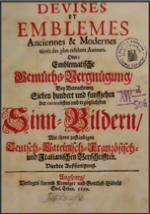
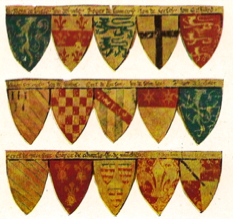
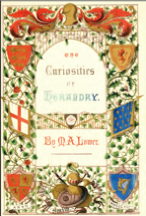
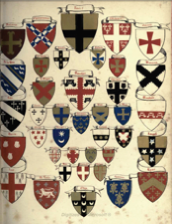
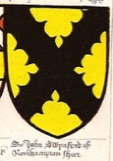
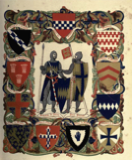
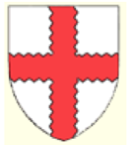
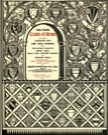


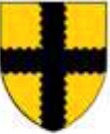
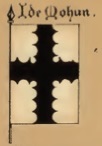
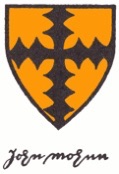
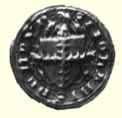
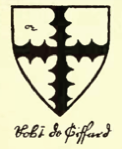
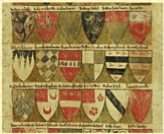
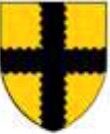


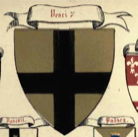
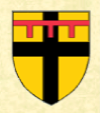
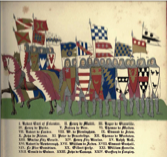


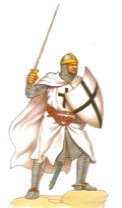
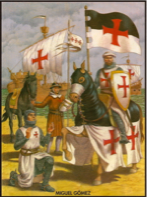
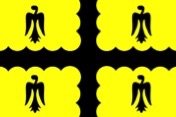


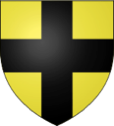
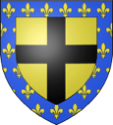
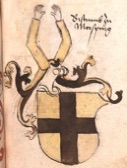
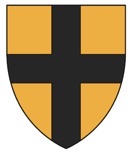
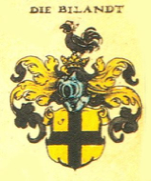
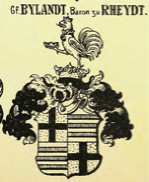
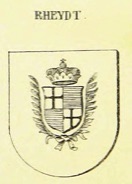
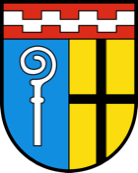
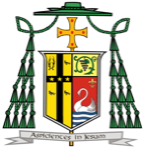
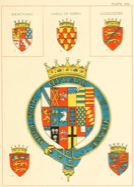
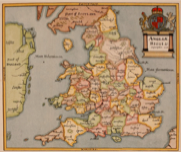
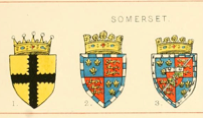
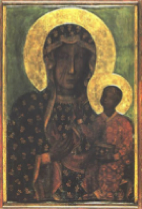
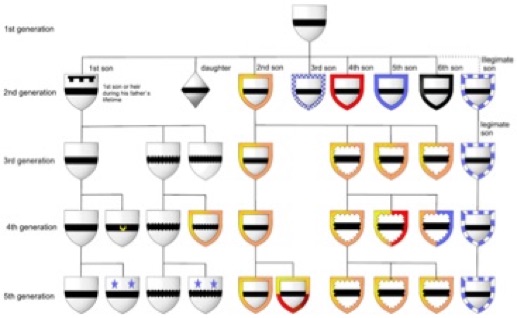
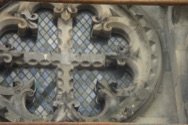
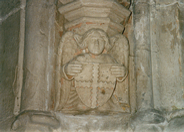
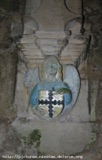

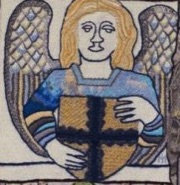
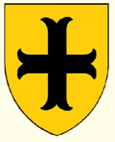
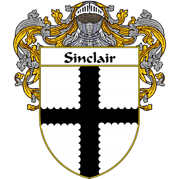
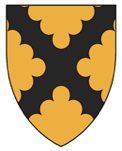
This might be interpreted to imply then that both Gervase de Rathe/Rait and his brother Andrew were third generation since their Coat of Arms has a cross engrailed on it.
In English heraldic practice the crest, the device or emblem that appears above the helmet or chapeau in a full coat of arms, should not duplicate any crest previously granted. Just as each shield should be unique, so too should each crest. In Scotland, however, it is permissible, and not uncommon, for two or more different families to bear the same crest. As Scottish heraldry joins the crest and motto in the crest badge, however, the combination of crest and motto should, in each case, be unique
Although members of a clan, or septs, may or may not have the same surname as their chief and thus be unrelated, Scottish heraldry operates under the proposition that all those who share the same surname are related, however distantly.
Differencing of Arms
The following is largely taken from Wikipedia - but it may shed light on Sir Gervase and Sir Andrew de Rait.
An armigerous clan is a Scottish clan, family or name which is registered with the Court of the Lord Lyon and once had a chief who bore undifferenced arms, but does not have a chief currently recognized as such by Lyon Court. Before 1745 all chiefs had arms; however, not all of these are recorded in the Public Register of All Arms and Bearings in Scotland, which was only established in 1672. In Scottish heraldry only chiefs or heads of clans, families, or names bear undifferenced arms. A clan is considered a "noble incorporation" because a clan chief is a title of honour in Scotland and the chief confers his or her noble status onto the clan. Because armigerous clans do not have such chiefs, they are not recognised as noble communities and have no legal standing under Scots law. It would appear that Rait is among the armigerous clans.
Undifferenced arms (or plain arms) are coats of arms which have no marks distinguishing the bearer by birth order or family position. In the Scottish and English heraldic traditions, these plain coats of arms are legal property transmitted from father to eldest male heir, and are used only by one person at any given time. The other descendants of the original bearer could bear the ancestral arms only with some difference. In Scottish heraldry there is no such thing as a "family coat of arms". Junior members of a family are assigned specific and relevant differences to the armorial bearings of an ancestor.
In heraldry, cadency is any systematic way of distinguishing otherwise identical coats of arms belonging to members of the same family. Cadency is necessary in heraldic systems in which a given design may be owned by only one person at once, generally the head of the senior line of a particular family. Because heraldic designs may be used by sons whilst their father is still alive, some form of differencing is required so as not to usurp the father's arms, known as the "undifferenced" or "plain coat". Historically arms were only heritable by males and therefore cadency marks have no relevance to daughters, except in the modern era in Canadian heraldry. These differences are formed by adding to the arms small and inconspicuous marks called brisures, similar to charges but smaller. They are placed on the fess-point, or in-chief in the case of the label. Brisures are generally exempt from the rule of tincture.
The system is very different in Scotland, where every male user of a coat of arms may only use arms recorded (or "matriculated") in the Public Register with a personal variation, appropriate to that person's position in their family, approved by the Lord Lyon (the heraldic authority for Scotland). This means that in Scotland no two men can ever simultaneously bear the same arms, even by accident, if they have submitted their position to the Scottish heraldic authorities (which not all do in practice, in Scotland as in England); if they have not done so, the matter falls under statute law and may result in proceedings in the Lyon Court, which is part of the Scots criminal justice system. To this extent, the law of arms is stricter in Scotland than in England where the only legal action possible is a civil action in the Court of Chivalry, which sits extremely rarely and is not an integrated part of the English justice system.
In the Scots heraldic system (which has little to do with the clan system), only one bearer of any given surname may bear plain arms. Other armigerous persons with the same surname usually have arms derived from the same plain coat; though if actual kinship cannot be established, they must be differenced in a way other than the cadency system mentioned above. This is quite unlike the English system, in which the surname of an armiger is generally irrelevant.
Scotland, like England, uses the label of three points for the eldest son (or heir presumptive) and a label of five points for the eldest son of the eldest son, and allows the label to be removed as the bearer of the plain coat dies and the eldest son succeeds.
For cadets other than immediate heirs, Scottish cadency uses a complex and versatile system, applying different kinds of changes in each generation. First, a bordure is added in a different tincture for each brother. In subsequent generations the bordure may be divided in two tinctures; the edge of the bordure, or of an ordinary in the base coat, may be changed from straight to indented, engrailed or invected; charges may be added. These variations allow the family tree to be expressed clearly and unambiguously. (The system outlined here is a very rough version that gives a flavour of the real thing. The image explains it better using variations on basic coat of arms argent a fess sable.)
On the Raitt Context page I have given some brief information on the Knights Templar who were active in Scotland in Mary and Nairn as well as Lothian. The St Clairs appear to have been long associated with the Templars, who met at their properties in Rosslyn. The Templars apparently venerated Mary Magdalene who is thought to be symbolized by the Black Madonna. I wonder whether the St Clair, Mohun, de Rathe Coat of Arms with its black cross and golden background might have a hidden meaning - the cross representing the Black Madonna and the background, her halo (image above right)?
A later example is Isaac Jogues, a Jesuit priest and missionary who worked among the native populations in North America. He was martyred in 1646 by the Mohawks near Auriesville, New York and was canonized in 1930. The left side of the shield of the fifth and current Archbishop of Detroit (Allen Vigneron) is the crest of the Archdiocese of Detroit which symbolically honours Michigan's spiritual father, St. Isaac Jogues amongst other entities. It is divided into four gold sections by a black cross embellished with various heraldic devices. The black and gold colours are from the shield of St. Isaac Jogues. (above right).
-----------
And in an old book dated 1879 and entitled The particular description of England. 1588 which gives views of some towne and armorial bearings of nobles and bishops, there are two which have a black cross on a yellow background: Earls of Derby, 1579 (left) and Somerset (1579) - the latter is engrailed.
And again though not engrailed, mention should be made of the Prince of Morea's arms. After the Fourth Crusade (1204) territory in the Peloponnese (known as Morea) was given by Boniface de Monferrat as a fief to William de Champlitte. After he had returned to France in 1209 it was governed by his bailiff Geoffrey de Villehardouin who prevented William to come back in time to effectuate his claim. In 1210 Geoffrey was proclaimed Prince of Morea by the nobles instead. The same year he was recognized by pope Innocentius III who used the name Achaia for the territory. He was succeeded by his son Guillaume II de Villehardouin (1246–1278) who as prince conquered the remaining territory of the Peloponnese and built the fortress of Mistra near Sparta. In 1249 he captured Monemvasia and later that year accompanied Louis IX of France on the Seventh Crusade, joining him in Cyprus with 400 knights and 28 ships. The coat of arms of Morea (below left) is said to have been Argent, a cross moline Sable with the legend: le prince de la moree. It is documented in the Camden Roll and also in the Herald's Roll as “Prince de la Morree, l’escu d’or od un fer de molyn de sable”.
Another instance of a similar arms, again though not engrailed, from the Armorial de Gelre is that of the ancient House of Bylandt originating in the Lower Rhine area of Germany in the late 13th century. The first member of the family, William Doys (1260-1288) was killed at the Battle of Worringen in 1288; his son Dietrich became the first to use the name “of Bylandt” in 1294. In 1500 three cadet branches were formed, one of which was called Bylandt-Rheydt. The family inherited Rheydt in Mönchengladbach, North-Rhine Westphalia and became known as the Barons of Rheydt, gaining much land in Austria, Germany and The Netherlands. The dynasty ruled Rheydt for over 300 years building a beautiful place (Schloss) of the same name. The arms below on the far left are those of Bylandt from the Armorial de Gelre; next to it are the arms of Bylandt-Rheydt from Siebmacher’s Wappenbuch. Also from the latter are the arms for the town of Rheydt and they are also incorporated into the present day coat of arms of Mönchengladbach (far right).
(The coat of arms of Sir Roger de Raitz (Raets), who is listed in the Armorial de Gelre as part of the retinue of the Archbishop of Cologne, is the exact reverse, namely a gold cross on a black ground.)
-----------
I have come across a couple of other examples of German arms showing a black cross (though not engrailed) on a gold ground. In the Wernigeroder (Schaffhausensches) Wappenbuch dating from the late 15th century there are the arms of the Bistumb zu Merspurg, i.e. Bishopric of Merseburg (which is mentioned in connection with the Bavarian Raitts.) The Bishopric of Merseburg was an episcopal see on the eastern border of the medieval Duchy of Saxony with its centre in Merseburg. Interestingly, the first Merseburg bishop was Boso, a Bavarian monk descending from St. Emmeram's Abbey in Regensburg. The see was founded in 967 by Emperor Otto I as part of a plan to bind the adjacent Slavic (Wendish) lands in the Saxon Eastern March more closely to the Holy Roman Empire. The see was suppressed from 971, but the prince-bishopric was re-established by King Henry II of Germany in 1004. It then covered a considerable small territory stretching from the river Saale up to the Mulde River and the Margraviate of Meissen in the east. The arms below at left are those of the Bistumb zu Merspurg and those on the right are for the Price-Bishopric of Merseburg.
Interestingly, the flag and coat of arms of Pays de Retz (Rais) is similar to that of Rait - though not engrailed. The district belonged to a family bearing that name, of which the eldest branch became extinct in the 13th century. The barony of Retz was constituted into a Duchy in 1581, later forming part of the Duchy of Brittany. The coat of arms of the Barons of Retz (d’or a la croix de sable) are mentioned in the Armorial Général by J. B. Rietstap (1884). Gui de Lavel-Rays had similar arms in the early 14th century (second from right below). Gilles de Montmorency-Laval (1405-1440), Baron de Rais (Retz), was a knight and lord from Brittany, Anjou and Poitou, a leader in the French army, and a companion-in-arms of Joan of Arc. He is best known for his reputation and later conviction as a presumed serial killer of children, as well as being the archetypical Bluebeard (arms at right below.)
Yves Helori de Kermartin was born in 1253 in Minihy-Treguier, Brittany. He became a remarkable lawyer, so much so that after his death in 1303 he was canonized in 1347 as the poor peoples' lawyer. Besides being the patron saint of Brittany, St. Yves or Ivo (in Breton, Erwann) is the patron saint of lawyers worldwide. His flag – which is also the banner of arms of the Helori of Kermartin family - is reputed to be either orange or yellow with a black engrailed cross and a black eagle in each quarter. A black cross on a white background was the traditional flag of the Duchy of Brittany and was granted to Duke Pierre Mauclerc by Pope Gregor IX about 1236. It appears to have been the national flag of the independent state of Brittany until 1532.
Whilst the cross of Crusaders was typically red on white (Templars - for the Hospitallers it was white on red), since the 13th century, a black cross on a white coat was carried by medieval Teutonic Knights which had founded the Monastic state of the Teutonic Knights in Prussia. Like the Templars, the Teutonic Knights served as a crusading military order during the Middle Ages. Formed at the end of the 12th century in Acre, in the Levant, the Order played an important role controlling the port tolls of Acre. The Order of the Teutonic Knights of St. Mary's Hospital in Jerusalem aided Catholics on their pilgrimages to the Holy Land and established hospitals to care for the sick and injured. Forced out of the Holy Lands following defeat of the Christians they relocated in various places, including Scotland.
Another William, 1st Earl of Caithness, started with the construction of Rosslyn Chapel at Roslin, in 1456. The Chapel has several carved examples of the Sinclair coat of arms.
The Sinclair coat of arms also appears in the panel depicting the story of Rosslyn Chapel in the Great Tapestry of Scotland. What is extremely interesting here, though, is that in the tapestry the coat of arms held by an angel at top left (see below left) is shown as a black engrailed cross on a gold background - the arms of Sir Gervaise de Rathe of Rait Castle - rather than on the white background for Sinclair! I thought this might be due to the carving (below right) having a yellowish tinge possibly because of a discolouration of the stonework due to grime, paint flaking off and perhaps mould over the centuries. However, it appears to be because of the colour of the sandstone itself which is in three colours in the Chapel - grey, yellow and red. (This particular panel was stolen on 10 September 2015 - see under Raitt Anecdotes!)
William de St. Clerc, born about 1283 in Rosslyn Castle, Roslin, Midlothia, joined the second Crusade and died in Spain in 1330. He was of a noble family of Norman origin who came over with William the Conqueror in 1066; one branch of which remained in England, and another settled in Scotland. From the latter branch are descended the families bearing the name St Clerc, or Sinclair. His coat of arms was Arg, a cross engrailed sable. The same arms are used by Henry Sinclair, Count of Orkney, in the Scottish section of the Armorial de Gelre.
Also having a black cross, though not engrailed, was William de Vesci. His coat of arms was Or, a cross sable. He was in Palestine in the Crusades in 1191; when in all probability he assumed the arms since borne by the family, in commemoration of his service there. He was of that baronial family of which Eustace de Vesci was the chief. Eustace fell out with King John and with several other barons fled to the north and raised the standard of rebellion. He was afterwards one of the signaturees on the Magna Carta. Descended from his race, are the families of Lacy Aton, Vescy of Ireland, and the Lords Knapton. The Vesci married the heiress of the principal branch of Eissum or Enson who were of Saxon origin and lords of Malton and Alnewick, Yorkshire. John de Vesci was also with the Earl of Lancaster in Palestine. The coats of arms for both William de Vescy (below left) and Jon de Veci (John de Vescy) appear in the “Dering” Roll which dates from 1270 and shows 324 coats of arms from Kent and Sussex. The arms on the right would probably be those of the 2nd generation, first son.
Sire John de Mohun (1270?–1330), whose father, also named John, died in France on 11 June 1279 was the 1st baron Mohun, and bore arms at the Battle of Falkirk in 1298 and the Siege of Carlaverock in 1300. He was also among those who sealed the Baron’s Letter to the Pope in 1301 where he is described as Lord of Dunsterre.
The seal on this letter is a cross engrailed and is remarkably similar to that of Sir Gervaise de Rait. His son, also John, died in 1322 and thus his grandson, another John (1320–1376), succeeded to the title at the age of ten to become the 2nd baron Mohun, lord of Dunster. Around 1341 John de Mohun received a summons to do service in Scotland, and in 1342 took part in the expedition into Brittany. After serving as a commissioner of array for the county of Somerset in 1346, he joined in the invasion of France, where he fought in the Battle of Crécy. He also appears in later years as one of the retinue of the Prince of Wales. He was one of the original knights of the Order of the Garter. The family came from Moyon near St. Lô in the department La Manche in Normandie. Around 1300 the present arms were changed to Or, a cross engrailed Sable. William de Moion al. Mohun, S.Dunster (d.c.1155) held 30 knight's fees in 1135. William joined Empress Maud and was created Earl of Somerset by her. The earldom was not recognized by King Stephen and none of his descendants were summoned as such by Henry II or later. The Barony of Mohun became extinct shortly after 1712.
The arms of Mohun, Or. a cross engrailed sa. are also given in the work by Joseph Edmondson who published his two volume treatise A Complete Body of Heraldry in 1780. Exactly, the same description is given for the arms of Gifford.
Giffard, Robert de (H. in. Roll) bore, or a cross engrailed sable. (F.) St. George Roll; blasoned fusily and tricked dancettee in Arden Roll.
Gifford, Robert (H. in. Roll) bore, argent, a cross engrailed sable, over all a gorge azure. (F.) Dering Roll. In the Dering Roll his arms also appear with blue concentric circles - such a design can represent a whirlpool. (See Brian Timm’s Order of Blazon.)
In the Roll of Arms of the Princes, Barons, and Knights who attended King Edward I. to the Siege of Caerlaverock in 1300 we find the entry:
Yellow with a black cross engrailed John de Mohun bore there.
The cross indented is very similar to a cross engrailed and could be easily misrepresented if not too well produced in the first place. Different branches of a family are apparently often indicated in heraldry by different colours (see below on Differencing of Arms) - so perhaps the fact that the Coat of Arms of later Raitt descendants is a black cross on a gold background indicates that they are descended from Gervase de Rathe rather than his brother Andrew despite the implications of the "Inheritance" letter of Edward I whereby Andrew received his brother’s property. Perhaps Gervase had children who later inherited the Rait lands and castle - although in 1297 it seems that Edward I gave Gervaise's lands to his brother Andrew - why it is not known, possibly the death of Gervaise.
However, as the following snippets show Rait is not completely unique in having a black cross on a white or gold background and it may be that their arms were acquired through unknown marriages nearly one thousand years ago.
One other piece of information concerns one of Scotland’s most emblematic relics - the Black Rood or Holy Rood - said to be a fragment of the cross on which Christ was crucified and set into an ebony crucifix.The Black Rood is reputed to have been brought to Scotland by Margaret of Wessex (later to become St Margaret in 1250 - image below left) who apparently was born in Hungary about 1045, but was in England during the reign of Edward the Confessor (1042-1066) who was her grand-uncle. She and her piece of the True Cross were supposedly accompanied to England by a certain William Sinclair. When the Normans invaded England in 1066, Margaret fled north, marrying King Malcolm III about 1070 and subsequently becoming the mother of three Scottish kings - Edgar, Alexander I and David I. On her death in 1093, Margaret is reported to have left the Rood to the Scottish people and it was kept in Holyrood Abbey in Edinburgh. The relic was removed from Scotland, along with the Stone of Scone and other Scottish memorabilia, in 1296 by Edward I, but was returned in 1328 at the request of King Robert the Bruce, though lost to the English again in 1346 after the battle of Neville’s Cross, after which it was held in Durham Cathedral until the Reformation in 1540 when it disappeared, presumed destroyed. However, legend has it that the cross was liberated from Durham by Simon Sinclair and subsequently hidden in Rosslyn Chapel (though historians apparently cannot find records of either of these two Sinclairs). However, intriguingly, in 1546, Mary of Guise - mother of Queen Mary - pledged to keep a secret about something that William Sinclair showed her in Rosslyn Chapel - speculation is rife that this was the Black Cross! An inventory made in England described the cross and its case in Latin soon after it was taken from Edinburgh in 1296 as; "Unum scrinium argenteum deauratum in quo reponitur crux que vocatur le blake rode” - “A silver-gilt casket in which lies the cross called the Black Rood”.
So, of course, this begs the question: does the black engrailed cross of the Rait family have anything to do with the Black Rood of Scotland? Did Gervase, or more likely, his ancestors, adopt it because of some connection to Margaret or her husband and kingly sons? Or were they indeed related to the Sinclairs (St Clerc) who have a similar coat of arms (though black on white rather than gold - see above)?
